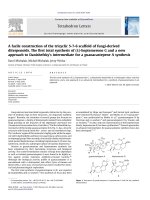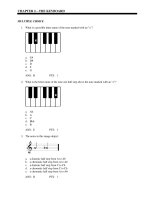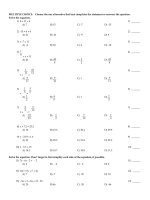Intermediate probability a comutational approach
Bạn đang xem bản rút gọn của tài liệu. Xem và tải ngay bản đầy đủ của tài liệu tại đây (3.82 MB, 432 trang )
Intermediate Probability
Intermediate Probability
A Computational Approach
Marc S. Paolella
Swiss Banking Institute, University of Zurich, Switzerland
Copyright 2007
John Wiley & Sons Ltd, The Atrium, Southern Gate, Chichester,
West Sussex PO19 8SQ, England
Telephone (+44) 1243 779777
Email (for orders and customer service enquiries):
Visit our Home Page on www.wileyeurope.com or www.wiley.com
All Rights Reserved. No part of this publication may be reproduced, stored in a retrieval system or
transmitted in any form or by any means, electronic, mechanical, photocopying, recording, scanning or
otherwise, except under the terms of the Copyright, Designs and Patents Act 1988 or under the terms of a
licence issued by the Copyright Licensing Agency Ltd, 90 Tottenham Court Road, London W1T 4LP, UK,
without the permission in writing of the Publisher. Requests to the Publisher should be addressed to the
Permissions Department, John Wiley & Sons Ltd, The Atrium, Southern Gate, Chichester,
West Sussex PO19 8SQ, England, or emailed to , or faxed to (+44) 1243 770620.
This publication is designed to provide accurate and authoritative information in regard to the subject matter
covered. It is sold on the understanding that the Publisher is not engaged in rendering professional services.
If professional advice or other expert assistance is required, the services of a competent professional should
be sought.
Other Wiley Editorial Offices
John Wiley & Sons Inc., 111 River Street, Hoboken, NJ 07030, USA
Jossey-Bass, 989 Market Street, San Francisco, CA 94103-1741, USA
Wiley-VCH Verlag GmbH, Boschstr. 12, D-69469 Weinheim, Germany
John Wiley & Sons Australia Ltd, 42 McDougall Street, Milton, Queensland 4064, Australia
John Wiley & Sons (Asia) Pte Ltd, 2 Clementi Loop #02-01, Jin Xing Distripark, Singapore 129809
John Wiley & Sons Canada Ltd, 6045 Freemont Blvd, Mississauga, Ontario, L5R 4J3, Canada
Wiley also publishes its books in a variety of electronic formats. Some content that appears
in print may not be available in electronic books.
Anniversary Logo Design: Richard J. Pacifico
Library of Congress Cataloging-in-Publication Data
Paolella, Marc S.
Intermediate probability : a computational approach / Marc S. Paolella.
p. cm.
ISBN 978-0-470-02637-3 (cloth)
1. Distribution (Probability theory)–Mathematical models. 2. Probabilities. I. Title.
QA273.6.P36 2007
519.2 – dc22
2007020127
British Library Cataloguing in Publication Data
A catalogue record for this book is available from the British Library
ISBN-13: 978-0-470-02637-3
Typeset in 10/12 Times by Laserwords Private Limited, Chennai, India
Printed and bound in Great Britain by Antony Rowe Ltd, Chippenham, Wiltshire
This book is printed on acid-free paper responsibly manufactured from sustainable forestry
in which at least two trees are planted for each one used for paper production.
Chapter Listing
Preface
Part I Sums of Random Variables
1 Generating functions
2 Sums and other functions of several random variables
3 The multivariate normal distribution
Part II Asymptotics and Other Approximations
4 Convergence concepts
5 Saddlepoint approximations
6 Order statistics
Part III More Flexible and Advanced Random Variables
7
8
9
10
Generalizing and mixing
The stable Paretian distribution
Generalized inverse Gaussian and generalized hyperbolic distributions
Noncentral distributions
Appendix
A Notation and distribution tables
References
Index
Contents
Preface
xi
Part I Sums of Random Variables
1
1 Generating functions
3
1.1 The moment generating function
1.1.1 Moments and the m.g.f.
1.1.2 The cumulant generating function
1.1.3 Uniqueness of the m.g.f.
1.1.4 Vector m.g.f.
1.2 Characteristic functions
1.2.1 Complex numbers
1.2.2 Laplace transforms
1.2.3 Basic properties of characteristic functions
1.2.4 Relation between the m.g.f. and c.f.
1.2.5 Inversion formulae for mass and density functions
1.2.6 Inversion formulae for the c.d.f.
1.3 Use of the fast Fourier transform
1.3.1 Fourier series
1.3.2 Discrete and fast Fourier transforms
1.3.3 Applying the FFT to c.f. inversion
1.4 Multivariate case
1.5 Problems
2 Sums and other functions of several random variables
2.1 Weighted sums of independent random variables
2.2 Exact integral expressions for functions of two continuous random
variables
3
4
7
11
14
17
17
22
23
25
27
36
40
40
48
50
53
55
65
65
72
viii
Contents
2.3 Approximating the mean and variance
2.4 Problems
3 The multivariate normal distribution
3.1
3.2
3.3
3.4
3.5
3.6
3.7
3.8
3.9
Vector expectation and variance
Basic properties of the multivariate normal
Density and moment generating function
Simulation and c.d.f. calculation
Marginal and conditional normal distributions
Partial correlation
Joint distribution of X and S 2 for i.i.d. normal samples
Matrix algebra
Problems
85
90
97
97
100
106
108
111
116
119
122
124
Part II Asymptotics and Other Approximations
127
4 Convergence concepts
129
4.1 Inequalities for random variables
4.2 Convergence of sequences of sets
4.3 Convergence of sequences of random variables
4.3.1 Convergence in probability
4.3.2 Almost sure convergence
4.3.3 Convergence in r-mean
4.3.4 Convergence in distribution
4.4 The central limit theorem
4.5 Problems
5 Saddlepoint approximations
5.1 Univariate
5.1.1 Density saddlepoint approximation
5.1.2 Saddlepoint approximation to the c.d.f.
5.1.3 Detailed illustration: the normal–Laplace sum
5.2 Multivariate
5.2.1 Conditional distributions
5.2.2 Bivariate c.d.f. approximation
5.2.3 Marginal distributions
5.3 The hypergeometric functions 1 F1 and 2 F1
5.4 Problems
130
136
142
142
145
150
153
157
163
169
170
170
175
179
184
184
186
189
193
198
Contents ix
6 Order statistics
6.1 Distribution theory for i.i.d. samples
6.1.1 Univariate
6.1.2 Multivariate
6.1.3 Sample range and midrange
6.2 Further examples
6.3 Distribution theory for dependent samples
6.4 Problems
203
204
204
210
215
219
230
231
Part III More Flexible and Advanced Random Variables
237
7 Generalizing and mixing
239
7.1 Basic methods of extension
7.1.1 Nesting and generalizing constants
7.1.2 Asymmetric extensions
7.1.3 Extension to the real line
7.1.4 Transformations
7.1.5 Invention of flexible forms
7.2 Weighted sums of independent random variables
7.3 Mixtures
7.3.1 Countable mixtures
7.3.2 Continuous mixtures
7.4 Problems
8 The stable Paretian distribution
8.1 Symmetric stable
8.2 Asymmetric stable
8.3 Moments
8.3.1 Mean
8.3.2 Fractional absolute moment proof I
8.3.3 Fractional absolute moment proof II
8.4 Simulation
8.5 Generalized central limit theorem
9 Generalized inverse Gaussian and generalized hyperbolic distributions
9.1 Introduction
9.2 The modified Bessel function of the third kind
9.3 Mixtures of normal distributions
239
240
244
247
249
252
254
254
255
258
269
277
277
281
287
287
288
293
296
297
299
299
300
303
x
Contents
9.4
9.5
9.6
9.7
9.3.1 Mixture mechanics
9.3.2 Moments and generating functions
The generalized inverse Gaussian distribution
9.4.1 Definition and general formulae
9.4.2 The subfamilies of the GIG distribution family
The generalized hyperbolic distribution
9.5.1 Definition, parameters and general formulae
9.5.2 The subfamilies of the GHyp distribution family
9.5.3 Limiting cases of GHyp
Properties of the GHyp distribution family
9.6.1 Location–scale behaviour of GHyp
9.6.2 The parameters of GHyp
9.6.3 Alternative parameterizations of GHyp
9.6.4 The shape triangle
9.6.5 Convolution and infinite divisibility
Problems
10 Noncentral distributions
10.1 Noncentral chi-square
10.1.1 Derivation
10.1.2 Moments
10.1.3 Computation
10.1.4 Weighted sums of independent central χ 2 random variables
10.1.5 Weighted sums of independent χ 2 (ni , θi ) random variables
10.2 Singly and doubly noncentral F
10.2.1 Derivation
10.2.2 Moments
10.2.3 Exact computation
10.2.4 Approximate computation methods
10.3 Noncentral beta
10.4 Singly and doubly noncentral t
10.4.1 Derivation
10.4.2 Saddlepoint approximation
10.4.3 Moments
10.5 Saddlepoint uniqueness for the doubly noncentral F
10.6 Problems
303
304
306
306
308
315
315
317
327
328
328
329
330
332
336
338
341
341
341
344
346
347
351
357
357
358
360
363
369
370
371
378
381
382
384
A Notation and distribution tables
389
References
401
Index
413
Preface
This book is a sequel to Volume I, Fundamental Probability: A Computational Approach
(2006), />70025948.html, which covered the topics typically associated with a first course in
probability at an undergraduate level. This volume is particularly suited to beginning
graduate students in statistics, finance and econometrics, and can be used independently of Volume I, although references are made to it. For example, the third equation
of Chapter 2 in Volume I is referred to as (I.2.3), whereas (2.3) means the third equation of
Chapter 2 of the present book. Similarly, a reference to Section I.2.3 means Section 3 of
Chapter 2 in Volume I.
The presentation style is the same as that in Volume I. In particular, computational
aspects are incorporated throughout. Programs in Matlab are given for all computations
in the text, and the book’s website will provide these programs, as well as translations
in the R language. Also, as in Volume I, emphasis is placed on solving more practical
and challenging problems than is often done in such a course. As a case in point,
Chapter 1 emphasizes the use of characteristic functions for calculating the density
and distribution of random variables by way of (i) numerically computing the integrals
involved in the inversion formulae, and (ii) the use of the fast Fourier transform. As
many students may not be comfortable with the required mathematical machinery, a
stand-alone introduction to complex numbers, Fourier series and the discrete Fourier
transform are given as well.
The remaining chapters, in brief, are as follows.
Chapter 2 uses the tools developed in Chapter 1 to calculate the distribution of sums
of random variables. I start with the usual, algebraically trivial examples using the
moment generating function (m.g.f.) of independent and identically distributed (i.i.d)
random variables (r.v.s), such as gamma and Bernoulli. More interesting and useful,
but less commonly discussed, is the question of how to compute the distribution of a
sum of independent r.v.s when the resulting m.g.f. is not ‘recognizable’, e.g., a sum of
independent gamma r.v.s with different scale parameters, or the sum of binomial r.v.s
with differing values of p, or the sum of independent normal and Laplace r.v.s.
Chapter 3 presents the multivariate normal distribution. Along with numerous examples and detailed coverage of the standard topics, computational methods for calculating the c.d.f. of the bivariate case are discussed, as well as partial correlation,
xii
Preface
which is required for understanding the partial autocorrelation function in time series
analysis.
Chapter 4 is on asymptotics. As some of this material is mathematically more challenging, the emphasis is on providing careful and highly detailed proofs of basic results
and as much intuition as possible.
Chapter 5 gives a basic introduction to univariate and multivariate saddlepoint
approximations, which allow us to quickly and accurately invert the m.g.f. of sums
of independent random variables without requiring the numerical integration (and
occasional numeric problems) associated with the inversion formulae. The methods
complement those developed in Chapters 1 and 2, and will be used extensively in
Chapter 10. The beauty, simplicity, and accuracy of this method are reason enough to
discuss it, but its applicability to such a wide range of topics is what should make this
methodology as much of a standard topic as is the central limit theorem. Much of the
section on multivariate saddlepoint methods was written by my graduate student and
fellow researcher, Simon Broda.
Chapter 6 deals with order statistics. The presentation is quite detailed, with numerous examples, as well as some results which are not often seen in textbooks, including
a brief discussion of order statistics in the non-i.i.d. case.
Chapter 7 is somewhat unique and provides an overview on how to help ‘classify’
some of the hundreds of distributions available. Of course, not all methods can be
covered, but the ideas of nesting, generalizing, and asymmetric extensions are introduced. Mixture distributions are also discussed in detail, leading up to derivation of
the variance–gamma distribution.
Chapter 8 is about the stable Paretian distribution, with emphasis on its computation,
basic properties, and uses. With the unprecedented growth of it in applications (due
primarily to its computational complexity having been overcome), this should prove to
be a useful and timely topic well worth covering. Sections 8.3.2 and 8.3.3 were written
together with my graduate student and fellow researcher, Yianna Tchopourian.
Chapter 9 is dedicated to the (generalized) inverse Gaussian and (generalized) hyperbolic distributions, and their connections. In addition to being mathematically intriguing, they are well suited for modelling a wide variety of phenomena. The author of
this chapter, and all its problems and solutions, is my academic colleague Walther
Paravicini.
Chapter 10 provides a quite detailed account of the singly and doubly noncentral
F, t and beta distributions. For each, several methods for the exact calculation of the
distribution are provided, as well as discussion of approximate methods, most notably
the saddlepoint approximation.
The Appendix contains a list of tables, including those for abbreviations, special
functions, general notation, generating functions and inversion formulae, distribution
naming conventions, distributional subsets (e.g., χ 2 ⊆ Gam and N ⊆ SαS), Student’s t
generalizations, noncentral distributions, relationships among major distributions, and
mixture relationships.
As in Volume I, the examples are marked with symbols to designate their relative
importance, with ,
and
indicating low, medium and high importance, respectively. Also as in Volume I, there are many exercises, and they are furnished with stars
to indicate their difficulty and/or amount of time required for solution. Solutions to all
exercises, in full detail, are available for instructors, as are lecture notes for beamer
Preface xiii
presentation. As discussed in the Preface to Volume I, not everything in the text is
supposed to be (or could be) covered in the classroom. I prefer to use lecture time for
discussing the major results and letting students work on some problems (algebraically
and with a computer), leaving some derivations and examples for reading outside of
the classroom.
The companion website for the book is />intermediate.
ACKNOWLEDGEMENTS
I am indebted to Ronald Butler for teaching and working with me on several saddlepoint approximation projects, including work on the doubly noncentral F distribution,
the results of which appear in Chapter 10. The results on the saddlepoint approximation for the doubly noncentral t distribution represent joint work with Simon Broda.
As mentioned above, Simon also contributed greatly to the section on multivariate
saddlepoint methods. He has also devised some advanced exercises in Chapters 1 and
10, programmed Pan’s (1968) method for calculating the distribution of a weighted
sum of independent, central χ 2 r.v.s (see Section 10.1.4), and has proofread numerous sections of the book. Besides helping to write the technical sections in Chapter 8,
Yianna Tchopourian has proofread Chapter 4 and singlehandedly tracked down the
sources of all the quotes I used in this book. This book project has been significantly
improved because of their input and I am extremely greatful for their help.
It is through my time as a student of, and my later joint work and common research
ideas with, Stefan Mittnik and Svetlozar (Zari) Rachev that I became aware of the
usefulness and numeric tractability via the fast Fourier transform of the stable Paretian
distribution (and numerous other fields of knowledge in finance and statistics). I wish
to thank them for their generosity, friendship and guidance over the last decade.
As already mentioned, Chapter 9 was written by Walther Paravicini, and he deserves
all the credit for the well-organized presentation of this interesting and nontrivial subject matter. Furthermore, Walther has proofread the entire book and made substantial
suggestions and corrections for Chapter 1, as well as several hundred comments and
corrections in the remaining chapters. I am highly indebted to Walther for his substantial
contribution to this book project.
One of my goals with this project was to extend the computing platform from Matlab
to the R language, so that students and instructors have the choice of which to use.
I wish to thank Sergey Goriatchev, who has admirably done the job of translating all
the Matlab programs appearing in Volume I into the R language; those for the present
volume are in the works. The Matlab and R code for both books will appear on the
books’ web pages.
Finally, I thank the editorial team Susan Barclay, Kelly Board, Richard Leigh,
Simon Lightfoot, and Kathryn Sharples at John Wiley & Sons, Ltd for making this
project go as smoothly and pleasantly as possible. A special thank-you goes to my
copy editor, Richard Leigh, for his in-depth proofreading and numerous suggestions
for improvement, not to mention the masterful final appearance of the book.
PART I
SUMS OF RANDOM VARIABLES
1
Generating functions
The shortest path between two truths in the real domain passes through the
complex domain.
(Jacques Hadamard)
There are various integrals of the form
∞
−∞
g(t, x) dFX (x) = E[g(t, X)]
(1.1)
which are often of great value for studying r.v.s. For example, taking g(n, x) = x n and
g(n, x) = |x|n , for n ∈ N, give the algebraic and absolute moments, respectively, while
g(n, x) = x[n] = x(x − 1) · · · (x − n + 1) yields the factorial moments of X, which
are of use for lattice r.v.s. Also important (if not essential) for working with lattice
distributions with nonnegative support is the probability generating function, obtained
x
1
by taking g(t, x) = t x in (1.1), i.e., PX (t) := ∞
x=0 t px , where px = Pr(X = x).
For our purposes, we will concentrate on the use of the two forms g(t, x) = exp(tx)
and g(t, x) = exp(itx ), which are not only applicable to both discrete and continuous
r.v.s, but also, as we shall see, of enormous theoretical and practical use.
1.1 The moment generating function
The moment generating function (m.g.f.), of random variable X is the function MX :
R → X≥0 (where X is the extended real line) given by t → E etX . The m.g.f. MX
is said to exist if it is finite on a neighbourhood of zero, i.e., if there is an h > 0
such that, ∀t ∈ (−h, h), MX(t) < ∞. If MX exists, then the largest (open) interval I
1 Probability generating functions arise ubiquitously in the study of stochastic processes (often the ‘next
course’ after an introduction to probability such as this). There are numerous books, at various levels, on
stochastic processes; three highly recommended ‘entry-level’ accounts which make generous use of probability
generating functions are Kao (1996), Jones and Smith (2001), and Stirzaker (2003). See also Wilf (1994) for
a general account of generating functions.
Intermediate Probability: A Computational Approach M. Paolella
2007 John Wiley & Sons, Ltd
4
Generating functions
around zero such that MX(t) < ∞ for t ∈ I is referred to as the convergence strip (of
the m.g.f.) of X.
1.1.1 Moments and the m.g.f.
A fundamental result is that, if MX exists, then all positive moments of X exist. This
is worth emphasizing:
If MX exists, then ∀r ∈ R>0 , E |X|r < ∞.
(1.2)
To prove (1.2), let r be an arbitrary positive (real) number, and recall that
limx→∞ x r /ex = 0, as shown in (I.7.3) and (I.A.36). This implies that, ∀ t ∈ R \ 0,
limx→∞ x r /e|tx| = 0. Choose an h > 0 such that (−h, h) is in the convergence strip of
X, and a value t such that 0 < t < h (so that E etX and E e−tX are finite). Then there
must exist an x0 such that |x|r < e|tx| for |x| > x0 . For |x| ≤ x0 , there exists a finite
constant K0 such that |x|r < K0 e|tx| . Thus, there exists a K such that |x|r < Ke|tx|
for all x, so that, from the inequality-preserving nature of expectation (see Section
I.4.4.2), E |X|r ≤ KE e|tX| . Finally, from the trivial identity e|tx| ≤ etx + e−tx and
the linearity of the expectation operator, E e|tX| ≤ E etX + E e−tX < ∞, showing
that E |X|r is finite.
Remark: This previous argument also shows that, if the m.g.f. of X is finite on
the interval (−h, h) for some h > 0, then so is the m.g.f. of r.v. |X| on the same
neighbourhood. Let |t| < h, so that E et|X| is finite, and let k ∈ N ∪ 0. From the Taylor series of ex , it follows that 0 ≤ |tX|k /k! ≤ e|tX| , implying E |tX|k ≤ k! E e|tX|
< ∞. Moreover, for all N ∈ N,
N
S(N ) :=
k=0
E |tX|k
k!
N
=
k=0
E |tX|k
=E
k!
N
k=0
|tX|k
k!
≤ E e|tX| ,
so that
∞
lim S(N ) =
N→∞
k=0
E |tX|k
≤ E e|tX|
k!
and the infinite series converges absolutely. Now, as |E (tX)k | ≤ E |tX|k < ∞, it
∞
k
k
follows that the series ∞
k=0 E (tX) /k! also converges. As
k=0 (tX) /k! converges
pointwise to etX , and |etX | ≤ e|tX| , the dominated convergence theorem applied to the
integral of the expectation operator implies
N
lim E
N→∞
k=0
(tX)k
k!
= E etX .
1.1 The moment generating function
That is,
∞
MX(t) = E etX = E
k=0
(tX)k
k!
∞
=
k=0
tk
E Xk ,
k!
(1.3)
which is important for the next result.
It can be shown that termwise differentiation of (1.3) is valid, so that the j th
derivative with respect to t is
∞
(j )
M X (t) =
i=j
t i−j
E Xi =
(i − j )!
∞
=E
n=0
∞
n=0
tn
E Xn+j
n!
∞
(tX)n Xj
n!
= E Xj
n=0
(tX)n
n!
= E Xj etX ,
(1.4)
or
(j )
M X (t)
t=0
= E Xj .
Similarly, it can be shown that we are justified in arriving at (1.4) by simply writing
(j )
M X (t) =
dj
dj tX
tX
= E Xj etX .
E
e
e
=
E
dt j
dt j
In general, if MZ(t) is the m.g.f. of r.v. Z and X = µ + σ Z, then it is easy to
show that
MX(t) = E etX = E et(µ+σ Z) = etµ MZ(tσ ) .
(1.5)
The next two examples illustrates the computation of the m.g.f. in a discrete and
continuous case, respectively.
Example 1.1
of X is
Let X ∼ DUnif (θ ) with p.m.f. fX (x; θ ) = θ −1 I{1,2,...,θ} (x). The m.g.f.
MX(t) = E etX =
1
θ
θ
etj ,
j =1
so that
MX(t) =
1
θ
θ
j etj ,
j =1
E [X] = MX(0) =
1
θ
θ
j=
j =1
θ +1
,
2
5
6
Generating functions
and
MX(t) =
1
θ
θ
j 2 etj ,
E X2 = MX(0) =
j =1
1
θ
θ
j2 =
j =1
(θ + 1) (2θ + 1)
,
6
from which it follows that
V (X) = µ2 − µ2 =
(θ + 1) (2θ + 1)
−
6
θ +1
2
2
=
(θ − 1)(θ + 1)
,
12
recalling (I.4.40). More generally, letting X ∼ DUnif(θ1 , θ2 ) with p.d.f. fX (x; θ1 , θ2 ) =
(θ2 − θ1 + 1)−1 I{θ1 ,θ1 +1,...,θ2 } (x),
E [X] =
1
(θ1 + θ2 )
2
and V(X) =
1
(θ2 − θ1 ) (θ2 − θ1 + 2) ,
12
which can be shown directly using the m.g.f., or by simple symmetry arguments.
Example 1.2
Let U ∼ Unif (0, 1). Then,
MU(t) = E etU =
1
0
etu du =
et − 1
,
t
t = 0,
which is finite in any neighbourhood of zero, and continuous at zero, as, via l’Hˆopital’s
rule,
et − 1
et
= lim = 1 =
t→0
t→0 1
t
1
lim
0
e0u du = MU(0).
The Taylor series expansion of MU(t) around zero is
et − 1
1
t3
t
t2
t2
=
t + + + ··· = 1 + + + ··· =
t
t
2
6
2
6
∞
j =0
1 tj
j + 1 j!
so that, from (1.3),
E U r = (r + 1)−1 ,
r = 1, 2, . . . .
(1.6)
In particular,
E [U ] =
1
,
2
E U2 =
1
,
3
V (U ) =
1 1
1
− =
.
3 4
12
Of course, (1.6) could have been derived with much less work and in more generality, as
E Ur =
1
0
ur du = (r + 1)−1 ,
r ∈ R>0 .
1.1 The moment generating function
For X ∼ Unif (a, b), write X = U (b − a) + a so that, from the binomial theorem
and (1.6),
r
E X
r
1
r r−j
br+1 − a r+1
,
a
=
(b − a)j
j
j +1
(b − a) (r + 1)
=
j =0
(1.7)
where the last equality is given in (I.1.57). Alternatively, we can use the location–scale
relationship (1.5) with µ = a and σ = b − a to get
MX(t) =
etb − eta
, t = 0,
t (b − a)
MX(0) = 1.
Then, with j = i − 1 and t = 0,
1
MX(t) =
t (b − a)
∞
=
j =0
bj +1
∞
i=0
(tb)i
−
i!
∞
k=0
a j +1
−
tj =
(j + 1)! (b − a)
(ta)k
k!
∞
∞
=
i=1
bi − a i i−1
t
i! (b − a)
bj +1
j =0
− a j +1 t j
,
(j + 1) (b − a) j !
which, from (1.3), yields the result in (1.7).
1.1.2 The cumulant generating function
The cumulant generating function (c.g.f.), is defined as
KX(t) = log MX(t) .
(1.8)
r
The terms κi in the series expansion KX(t) = ∞
r=0 κr t /r! are referred to as the
cumulants of X, so that the ith derivative of KX(t) evaluated at t = 0 is κi , i.e.,
κi = K(i)
X (t)
t=0
.
It is straightforward to show that
κ1 = µ,
κ2 = µ2 ,
κ3 = µ3 ,
κ4 = µ4 − 3µ22
(1.9)
(see Problem 1.1), with higher-order terms given in Stuart and Ord (1994, Section 3.14).
Example 1.3
From Problem I.7.17, the m.g.f. of X ∼ N µ, σ 2 is given by
1
MX(t) = exp µt + σ 2 t 2 ,
2
1
KX(t) = µt + σ 2 t 2 .
2
(1.10)
7
8
Generating functions
Thus,
KX(t) = µ + σ 2 t,
E [X] = KX(0) = µ,
KX(t) = σ 2 ,
V (X) = KX(0) = σ 2 ,
2
4
and K(i)
X (t) = 0, i ≥ 3, so that µ3 = 0 and µ4 = κ4 + 3µ2 = 3σ , as also determined
3/2
directly in Example I.7.3. This also shows that X has skewness µ3 /µ2 = 0 and
kurtosis µ4 /µ22 = 3.
For X ∼ Poi (λ),
Example 1.4
∞
MX(t) = E e
tX
=
x=0
etx e−λ λx
= e−λ
x!
∞
x=0
λet
x!
x
= exp −λ + λet .
(1.11)
t
As K(r)
X (t) = λe for r ≥ 1, it follows that E [X] = KX(t) t=0 = λ and V (X) =
KX(t) t=0 = λ. This calculation should be compared with that in (I.4.34). Once the
m.g.f. is available, higher moments are easily obtained, in particular,
3/2
skew(X) = µ3 /µ2
and
= λ/λ3/2 = λ−1/2 → 0
kurt(X) = µ4 /µ22 = κ4 + 3µ22 /µ22 = λ + 3λ2 /λ2 → 3,
as λ → ∞. That is, as λ increases, the skewness and kurtosis of a Poisson random
variable tend towards the skewness and kurtosis of a normal random variable.
For X ∼ Gam (a, b), the m.g.f. is, with y = x (b − t),
Example 1.5
MX(t) = E etX
=
=
ba
(a)
b
b−t
∞
0
x a−1 e−x(b−t) dx = (b − t)−a ba
∞
1 a−1 −y
y e dy
(a)
0
a
,
t < b.
From this,
E [X] =
dMX(t)
dt
=a
t=0
b
b−t
a−1
b (b − t)−2
=
t=0
a
b
or, more easily, with KX(t) = a (ln b − ln (b − t)), (1.9) implies
κ1 = E [X] =
dKX(t)
dt
=
t=0
a
b−t
=
t=0
a
b
(1.12)









